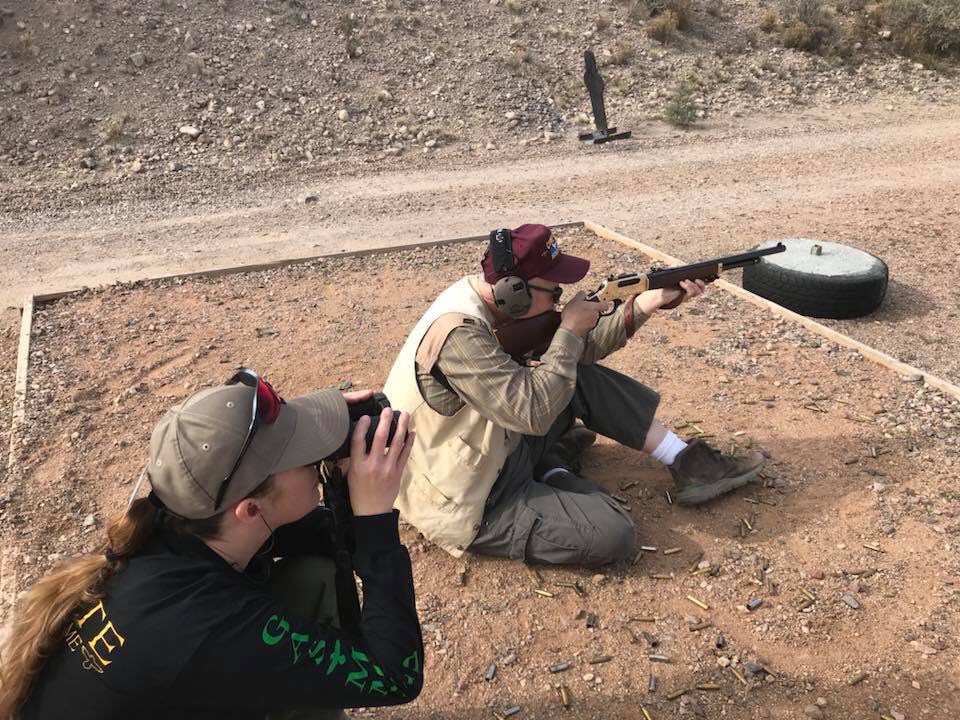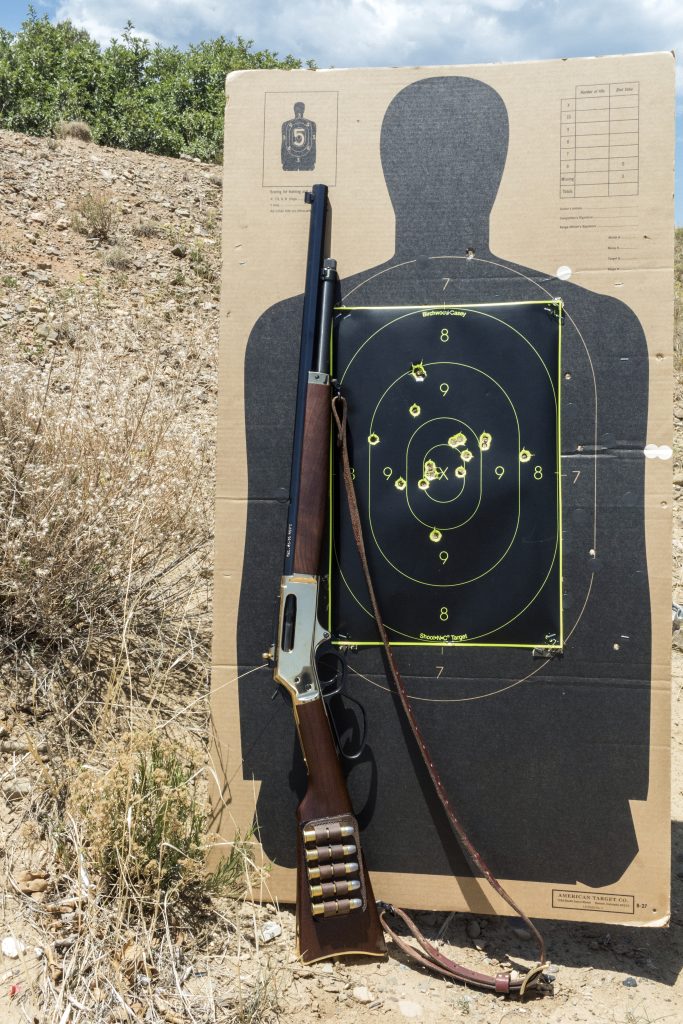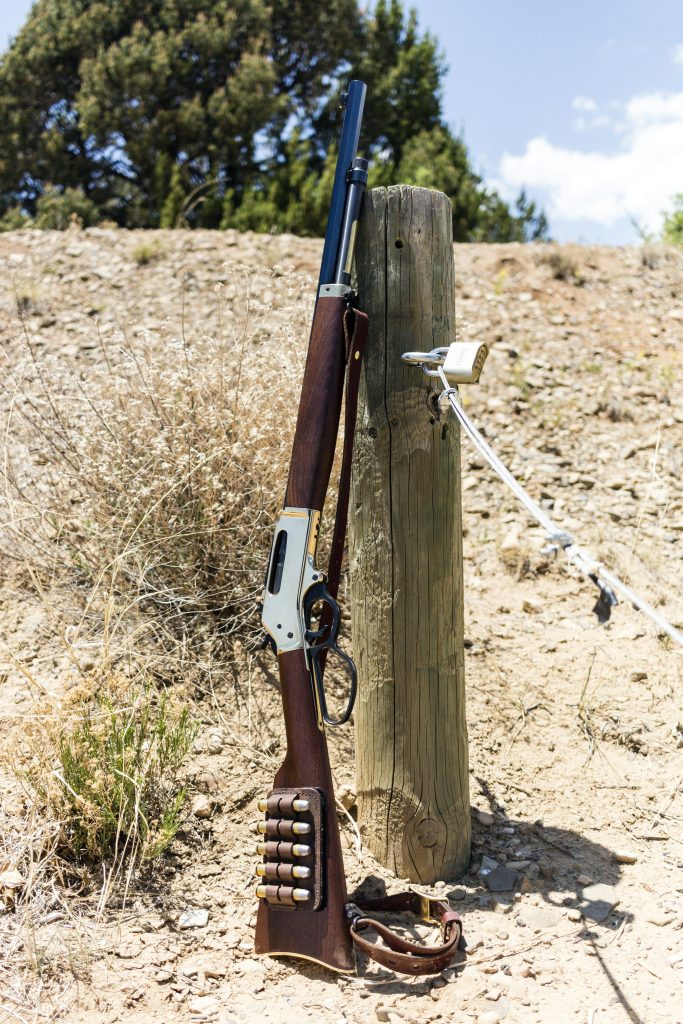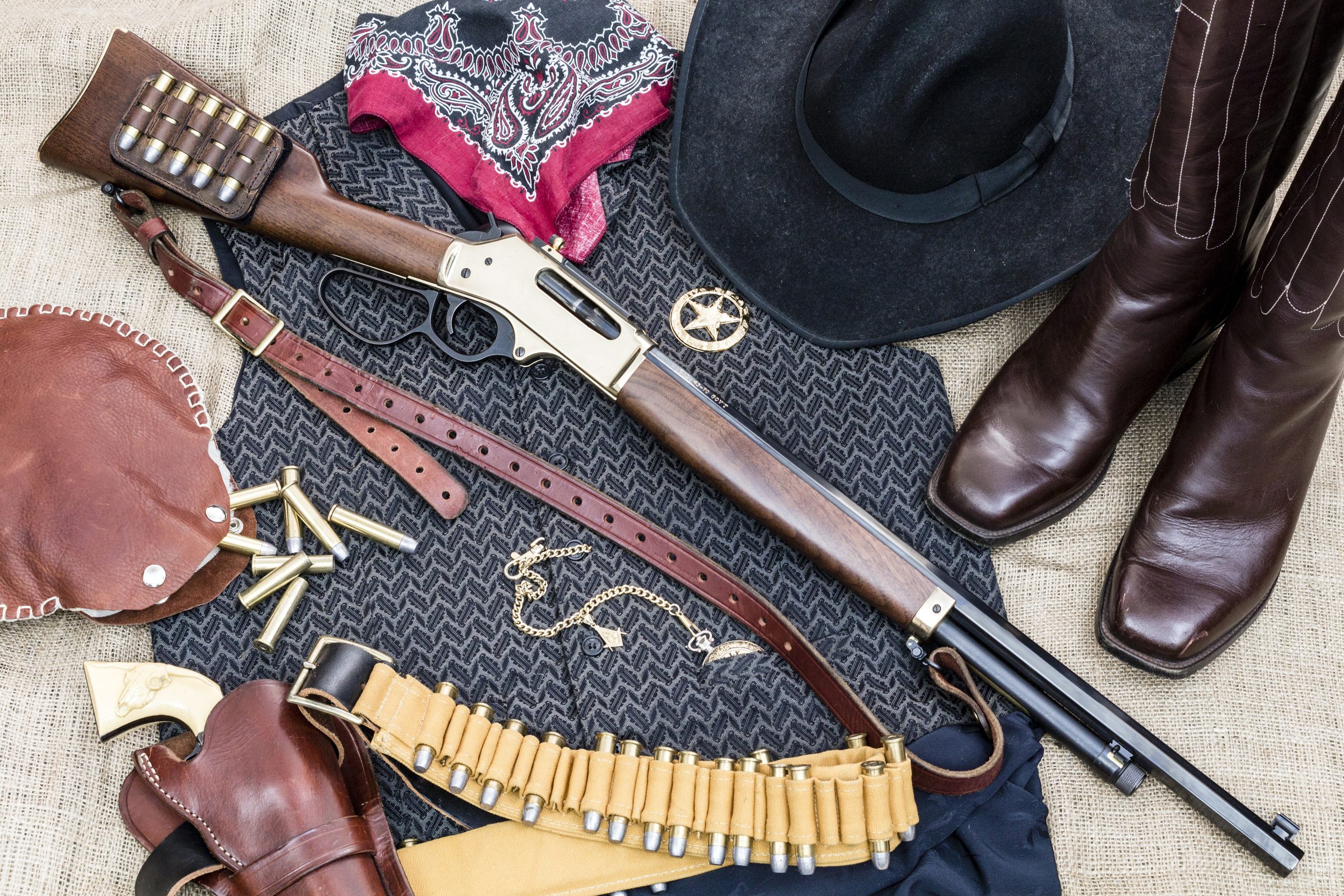This Iconic Firearm Has Been America’s Choice for Over 180 Years
Arguably the first lever-gun was patented by Samuel Colt in 1837 when he invented a revolving rifle actuated by a ring lever. Since that time the lever-gun has evolved from the primitive Volcanic Arms repeating handgun to the original Henry .44 Rimfire lever-action rifle to the Winchester Model 1866, which spawned the Model 1873, the large caliber Model 1876, then John Browning’s large-bore Model 1886 and the reduced size Model 1892; then the Model 1894, which heralded in smokeless powder cartridges and the Model 1895, which used a box magazine allowing spritzer-type cartridges.
In between and afterward came repeating lever-guns from Burgess, Colt, Marlin, Savage, Spencer, and Whitney. In modern times this list has been supplemented by lever-action rifles from Browning and a host of imported Old West-style replicas from such makers as Pietta and Uberti. Today many riflemen might be more inclined towards bolt-action or semi-automatic rifles, but given the time period involved, the lever-action rifle is still America’s Rifle!
The Lever-Gun & the Old West
Undisputedly the lever-action rifle was also the choice of Old West fighting men; especially after the introduction of fixed metallic cartridge firing guns like the Henry and the Winchester Model 1866. Town Marshals, County Constables, and Sheriffs; plus state organizations like the Texas Rangers, Arizona Rangers, New Mexico Mounted Police, Colorado Rangers, and then Federal outfits like the U.S. Marshals all used lever-actions. It’s been said that handguns such as a Colt Peacemaker or Smith & Wesson American are what you have on you and are best used to fight your way back to your rifle. That truism is as valid today as it was over a century ago.
Advertisement — Continue Reading Below
Serious fighting when you need power, accuracy, cartridge capacity, and operation at variable distances; the rifle is what you reach for. Men like Sheriff Commodore Perry Owens who relied on a Winchester Model 1886 in .45-70 to win the shoot-out at the Blevins House in Holbrook, AZ in 1887; bad man Emmet Dalton used his 1886 Winchester in .40-60 to down 3 towns-people and kill the town marshal during the Coffeyville bank raid in 1892; agencies like the Arizona Rangers and New Mexico Mounted Police armed their officers with Model 1895 Winchesters in .30-40 Gov. Range Detective Tom Horn favored a .30-30 for long-range shots. Even modern Texas Rangers like Juaquin Jackson still preferred lever-guns for fighting right into the late 20th Century. Serious gunfighters have always used serious firearms.
The Lever-Gun of Today
Today, the lever-gun can still be pressed into service for citizen self-defense or even law enforcement chores. Lots of these rifles and carbines are hanging on the walls, hiding behind doors, or residing in gun safes in homes and station houses. While their primary use may be hunting or cowboy action shooting; they can still pack a punch and have plenty of firepower if they are needed for protection against two-legged predators.
One feature I happen to like in a fighting lever-gun is the ability to “load while you go”. As most lever-actions have a loading gate located on the right side of the receiver; you can shoot 2, load, 2, shoot, load, and there is no detachable magazine that has to be replaced after the cartridges in it are expended. Conversely, there’s no box magazine to keep up with or damage in a rough fight. Cartridges in belt loops, a stock carrier, or even a pocket can be loaded as needed with most lever-guns.
Advertisement — Continue Reading Below
The Fighting Lever-Gun: Henry Repeating Arms Brass Lever Action Rifle
I wanted to check out a “fighting lever-gun” in a large caliber that would have been just as at home in the Old West as it is today in 21st Century America. Turns out the only rifle I had that met this requirement was a Henry Repeating Arms (HRA) Brass Lever Action Rifle in .45-70 Gov. The .45-70 was selected as our military service rifle cartridge in 1873 and served during the Indian Wars, the Spanish American War, and the Philippine Insurrection.
Its big-bore, heavyweight lead bullet had excellent knock-down power and was also prevalent on the plains with buffalo hunters. Today it is still a popular cartridge and besides the old 405-grain lead bullet load, there are lighter-weight, expanding, hunting-type bullets that provide higher velocities and improved accuracy. My Henry is a big robust rifle and has digested many rounds of these various types with (depending on the cartridge) near 100% reliability.

Advertisement — Continue Reading Below
The HRA .45-70 has lots of Old West flavor sporting a mirror-finished brass receiver, brass forend cap, and brass curved butt plate. Add to that a richly polished and blued 22” octagonal barrel, magazine tube, large loop lever, trigger, and hammer; plus an attractive American walnut stock and forend. This provides a very pleasing visual in addition to a host of other features like a fully adjustable semi-buckhorn rear sight, brass bead front sight (both mounted in dovetails), a receiver that is drilled and tapped for other sight options, sling swivel studs, and an internal transfer bar safety system. This is a solid rifle weighing 8.10 pounds empty, with a 14” length of pull and an overall length of 41.1”. It is both ruggedly built and superbly fit and finished, with no external blemishes or manufacturing shortcuts.
Customization
To make my HRA .45-70 the kind of close-to-intermediate-range fighting rifle I envisioned I made a few additions. First, I’m not a real fan of semi-buckhorn rear sights, so I knocked the sight out of its dovetail in the barrel and in its place affixed a Skinner Sights LLC rear sight to the top of the brass receiver. The sight I chose was their Express model which has a blue steel base, with the peep portion in brass with a replaceable blue aiming aperture. It not only looks great but is easily attached using the already tapped holes and works very well with the factory brass bead front sight. I selected the widest of the 3 apertures provided to use making it almost a “ghost ring” type sight picture.
The Lever-Gun Goes to Gunsite
I once attended a gun writer’s conference at Gunsite and as a result, I added swivels and a sling to my HRA .45-70 that was made by Andy’s Leather. The version selected was their Rhodesian Scout Rifle two-point sling in walnut-stained bridle leather, with solid brass hardware and 1.25” in width. It has a forward loop and is holed almost the entire length for adjustment. As such it is useful for both shooting support and as a carrying strap for the rifle. Another addition was the Ammo Caddy from Versa Carry. This water buffalo leather, hand-stitched, 5-cartridge slide can be used on a 1.5” belt or with super self-adhesive, aerospace-grade Velcro pile pads the slide can be attached to the rifle butt or almost any flat surface. The Ammo Caddy comes in models to fit 26 different cartridge calibers and additional Velcro pads are available for your mounting options.
Advertisement — Continue Reading Below
A number of gun scribes and experienced shooters enjoyed expert instruction on the use of lever-action rifles and carbines from expert Gunsite instructors Ed Head, Lew Gosnell, and Gary Smith. The emphasis of the course was the practical use of lever guns that might be pressed into service for defensive purposes. The first order of business was a safety brief and then gun handling and basic marksmanship to get an idea of the student’s experience and ability levels. Different shooting positions were covered, plus the use of the sling in two carry modes and as a shooting support. Other topics included rifles, ammo, sights, and various other insights that were presented over the 3-day event.
Various Shooting Positions
The shooting was then done from low and high ready positions, kneeling, sitting, and prone with and without a rest. Paper targets were used at first and then we moved on to steel. Generally, the chamber was loaded and the hammer down before the signal to fire was given. One skill emphasized was shooting and loading, which of course was a challenge with the Henry and its magazine tube loading port. I learned to raise the rifle up near eye level and open up the magazine tube; dropping my cartridges in rather hurriedly. We did sling rifles to shoot transitions and loading from belt loops or the Versa Carry Ammo Caddy on the rifle butt-stock. After two days, we were pretty familiar with our lever-guns.

Advertisement — Continue Reading Below
For .45-70 ammunition to use in the Henry rifle, I chose two traditional 405 gr. flat point lead bullet loads, made primarily for Cowboy Action Shooting, from Black Hills and HSM. Modern performance loads came from Barnes, which features their 300 gr. VOR-TX solid copper hollow-point; Black Hills Gold 325 gr. Honey Badger; and Hornady LEVERevolution 325 gr. FTX cartridges. Next, it was off to the range to see what these cartridges would do velocity-wise out of the HRA Brass .45-40 lever-guns 22” barrel. I set up my Oehler Model 35P Chronograph and shot 5 rounds of each test load through the Sky Screens. The cartridges going off really buffeted the Sky Screens, but all was well and you can see the data in the performance table provided. By the way, the chronograph and target shooting was conducted at the NRA Whittington Center ranges near Raton, New Mexico.
Bench Shooting
Next, I put my sandbag on the bench and set my Birchwood Casey Shoot-N-C large oval bulls-eye targets out at the 50-yard line to do a potential accuracy evaluation. With the iron sights I was using, I felt that this was a sufficient distance for the purposes I meant for the Henry .45-70 lever-gun. Three 5-shot groups were fired with each test cartridge and at the distance specified, the Skinner Express peep sight with the HRA brass bead front sight shot to point of aim when I sighted on the center X-ring of the target. I was very surprised to find that my best group was made with the Black Hills Gold Honey Badger bullet – the cluster of holes at 2 o’clock in the 10-ring measured just 1.64”. Black Hills also took second place with a 1.67” group using the Cowboy cartridges. The remaining data is in the performance table.
Load As You Go
One thing I learned using the Henry Brass .45-70 at Gunsite was there is no load-as-you-go. Henry Lever Action Rifles all load through a loading port cut into the magazine tube, just forward of the forend. If you expend all the rounds in your rifle and the fight is still on; the best thing to do is load single rounds through the open ejection port (which is done handily) and this is where the Versa Carry Ammo Caddy on the butt-stock becomes necessary. Load the magazine through the port when you are under cover and there’s a lull in the action. Watch grabbing the barrel; after a shooting magazine full, it gets hot!
Advertisement — Continue Reading Below
Another lesson was that the X/+-shaped bullet nose of the Black Hills Honey Badger round is not conducive to feeding in the HRA lever-gun. Best to keep one in the chamber and a few in the Ammo Caddy. All of the other .45-70 cartridges were fed with no issues (if the lever is worked vigorously); ejection was positive with all the test loads.

Practical Shoot
My son Jordan was helping me and taking photos at the range. I wanted to do a practical-type shoot with the HRA Brass .45-70 on a paper target, but my right shoulder needed a rest, so I recruited him to do it. A short course that I conceived was to load up the Henry to full capacity (7 rounds) and 5 cartridges in the Versa Carry Ammo Caddy. Shooting would begin standing, out in the open at 10 yards engaging a B-27 silhouette target with a Shoot-N-C center. From a ready position, on signal 5 rounds would be fired as quickly as possible shooting using a flash sight picture.
Advertisement — Continue Reading Below
A tactical retreat was then made back to 25 yards and from a kneeling position, the last two rounds in the rifle were fired using the sights. The Henry was then fired loading through the port 4 times and after the 5th round was loaded, the hammer was lowered and a strategic retreat was made back to the 50-yard barricade. Here from the right-side barricade, standing, the chambered round was fired, and then under cover, 5 rounds were loaded into the magazine and then the target was re-engaged with those cartridges. A mix of test ammo was used; the Honey Badger loads were fired only when loaded singly. All of the holes stayed in the black and all were in the 9, 10, and X-rings of the target.
Shooting in Teams
On the last day, we shot several interesting and challenging exercises; pressure was added as we were shooting in teams and prizes were given to the top shooter in each event. There was shooting at steel from various distances behind cover; kind of a “Hogan’s Alley” affair. We shot another which had targets from 200 down to about 50 yards where we had to shoot from whatever position we chose, run up to the next location, get the rifle “topped off” in the process, and shoot again. Another memorable stage was shooting at steel standing unsupported and those that hit the target moved back until there was the “last shooter standing.” The balance of the day was spent informally shooting a bunch of lever-guns two sponsors brought along, plus each other’s guns. We also did some ballistic gelatin bullet testing. All in all, it was a rousing good time.

Advertisement — Continue Reading Below
The Lever-Gun at NRA’s Whittington Center
For some steel-shooting fun, we went to one of the NRA’s new ranges where various steel targets were positioned anywhere from 50 to 550 yards away. Again, using a mix of cowboy and performance .45-70 test ammo we shot at swingers, gongs, fixed circles, squares, oblongs, and finally a 4’x4’ diamond-shaped steel target set up on the side of a small mountain that was around 550 yards away. We made regular hits on the closer in even targets at around 300 yards, but that big diamond on the mountain; the best we could do was scare it badly! We had a blast and I think the Whittington Center is going to find that this will be one of its most popular ranges.
As I mentioned before I had previously taken the HRA Brass .45-70 to a three-day lever-gun shooting event at Gunsite. Because if that it had already digested somewhere over 200 rounds of ammunition before we did the formal T&E at the NRA ranges. It performed very well at Gunsite. One of the other gun writers that attended the event remarked to me that the accuracy and reliability of the Henry was much better than he had expected. It so happened that I was the only Henry user in the group, but I think me and my big Brass lever-gun made believers out of many of them. If you want a rugged, yet handsome and accurate .45-70 lever action rifle then I don’t think you can go wrong checking out the offerings from Henry Repeating Arms.
Henry RA Brass Lever Action Specifications:
Mechanism: Traditional lever-action repeater
Caliber: .45-70 Gov.
Capacity: 6+1 cartridges
Barrel: 22.0 in. (1:20 twist)
OA Length: 41.1 in.
Empty Weight: 8.10 lbs.
Sights: Fully adj. semi-buckhorn rear; brass bead front
Finish: Brass receiver and blue barrel
Stock: American walnut
Henry RA .45-70 Lever Action Rifle Performance:
| Cartridge | Ave. Velocity | Best Group | Average Group |
| Barnes VOR-TX 300 gr. Solid Copper HP | 1921 FPS | 2.18” | 2.24” |
| Black Hills 325 gr. Honey Badger | 2587 FPS | 1.64” | 1.79” |
| Black Hills Cowboy 405 gr. FPL | 1238 FPS | 1.67” | 1.97” |
| Hornady 325 gr. FTX LEVERevolution | 2043 FPS | 1.69” | 1.95 |
| HSM Cowboy 405 gr. RFP | 1292 | 2.51” | 2.64” |
NOTE: Bullet weight measured in grains, velocity in feet per second 10 ft. from the muzzle by an Oehler Model 35P chronograph, and accuracy in inches for three 5-shot groups at 50 yards.























